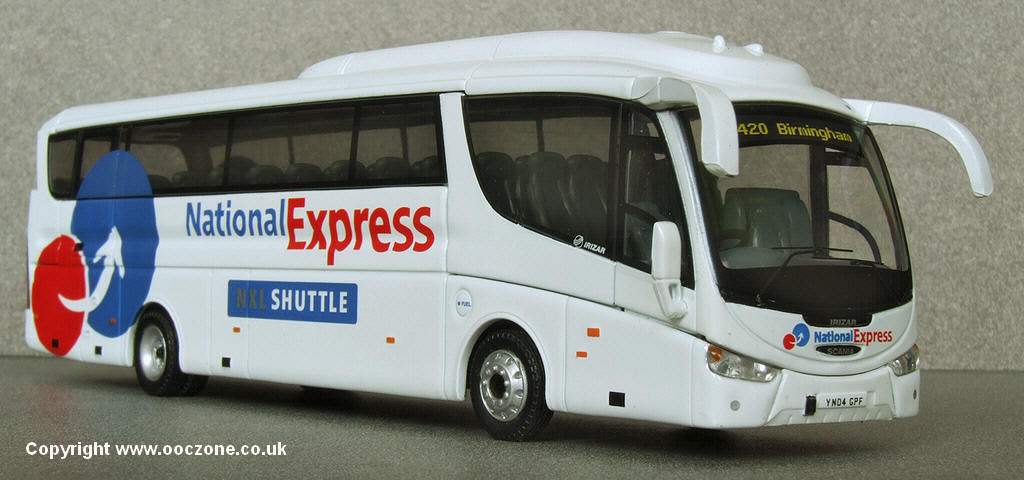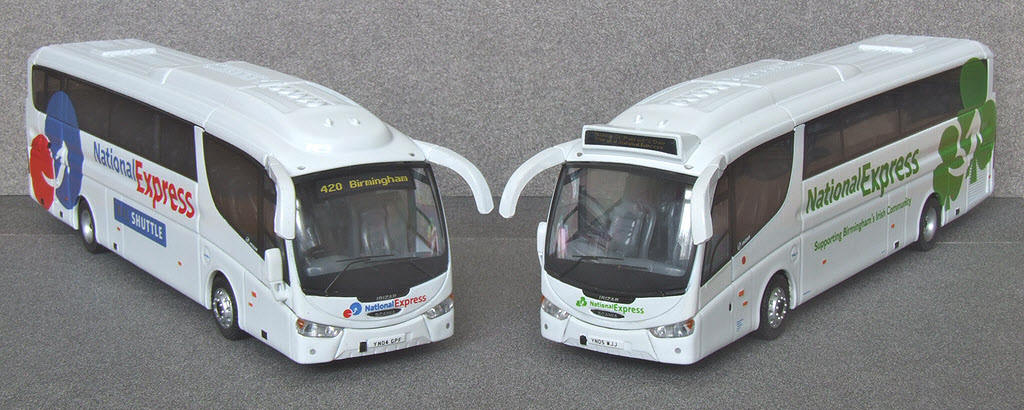
Corgi OM46201 Scania Irizar PB
National Express NXL
Released July 2008
Review by Kevin Ellis
 Corgi's
latest OOC tooling brings us the distinctive lines of the Scania Irizar
PB coach. Originally announced in the 2007 catalogue, the model's
release has been delayed almost 11 months by the problems that preceded
Corgi's takeover by Hornby earlier this year.
Corgi's
latest OOC tooling brings us the distinctive lines of the Scania Irizar
PB coach. Originally announced in the 2007 catalogue, the model's
release has been delayed almost 11 months by the problems that preceded
Corgi's takeover by Hornby earlier this year.
 The
model reviewed here is the National Express
NXL
Shuttle OM46201 with
Birmingham destination: this particular model is
a certificated run of 2932 pieces, half of which have an alternative
London destination. The coach modelled, YN04 GPF, was one of fourteen
such vehicles purchased in 2004 by National Express principally for use
on the newly introduced London to Birmingham 420 service. The vehicles
were delivered in the latest National Express livery although for a time
YN04 GPF carried a special Irish shamrock livery similar to that
depicted on the other OOC Irizar PB release OM46202.
The
model reviewed here is the National Express
NXL
Shuttle OM46201 with
Birmingham destination: this particular model is
a certificated run of 2932 pieces, half of which have an alternative
London destination. The coach modelled, YN04 GPF, was one of fourteen
such vehicles purchased in 2004 by National Express principally for use
on the newly introduced London to Birmingham 420 service. The vehicles
were delivered in the latest National Express livery although for a time
YN04 GPF carried a special Irish shamrock livery similar to that
depicted on the other OOC Irizar PB release OM46202.
National Express were obviously impressed with their new Irizars and purchased a further larger batch of vehicles during 2005: this second batch differed from the first fourteen by having their front destination equipment mounted on the roof rather than behind the windscreen.
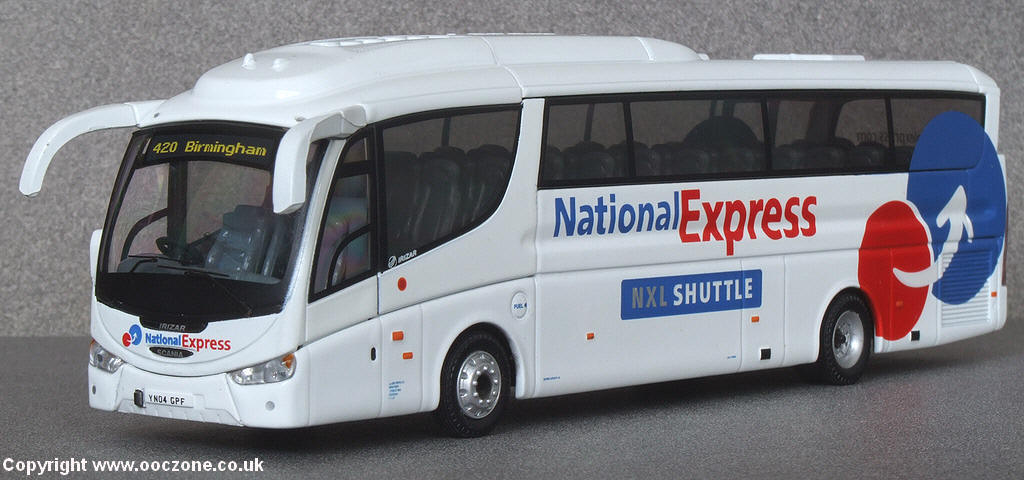 The
Irizar PB has also found favour with a number of other well known
operators; Bus Eireann, Flights, Mayne, Harry Shaw and the First Group
are among those who currently operate examples.
The
Irizar PB has also found favour with a number of other well known
operators; Bus Eireann, Flights, Mayne, Harry Shaw and the First Group
are among those who currently operate examples.
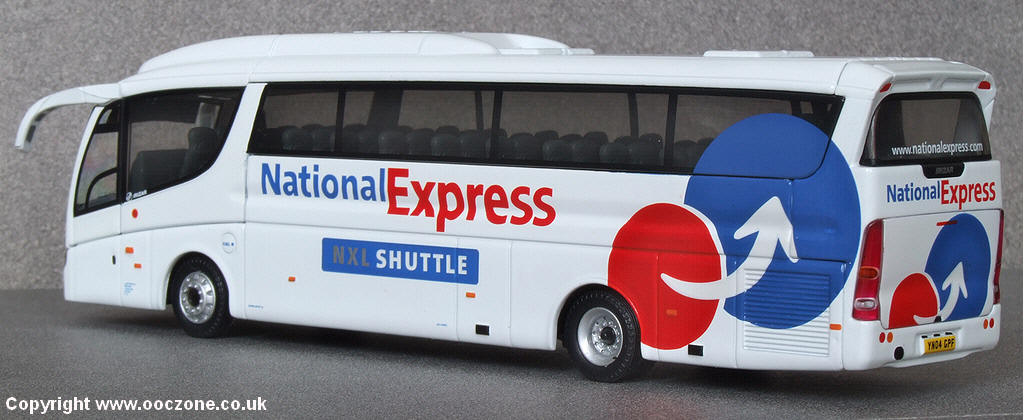 This
model has a high die-cast content giving it a nice weighty feel: the
main plastic content is restricted to the glazing and internal
detailing. Like the recent OOC Plaxton coaches the plastic glazing
components have been over painted with the body colour to form the
subtle curves on forward side windows and windscreen surround, most of
the other glazing detail is applied in the form of black tampo printing;
this does a good job of recreating the vehicles sleek flush glazing.
This
model has a high die-cast content giving it a nice weighty feel: the
main plastic content is restricted to the glazing and internal
detailing. Like the recent OOC Plaxton coaches the plastic glazing
components have been over painted with the body colour to form the
subtle curves on forward side windows and windscreen surround, most of
the other glazing detail is applied in the form of black tampo printing;
this does a good job of recreating the vehicles sleek flush glazing.
 The
NXL
Shuttle version has the destination display in the front windscreen. On
the model the actual destination information has been printed on the
outside of the glazing rather than the inside which is a little
disappointing. A second version of the model has also been released in
the special green and white Irish livery and this has an alternative
roof mounted destination box, this plastic addition fits very snugly
onto the curved front end of the roof air-con unit.
The
NXL
Shuttle version has the destination display in the front windscreen. On
the model the actual destination information has been printed on the
outside of the glazing rather than the inside which is a little
disappointing. A second version of the model has also been released in
the special green and white Irish livery and this has an alternative
roof mounted destination box, this plastic addition fits very snugly
onto the curved front end of the roof air-con unit.
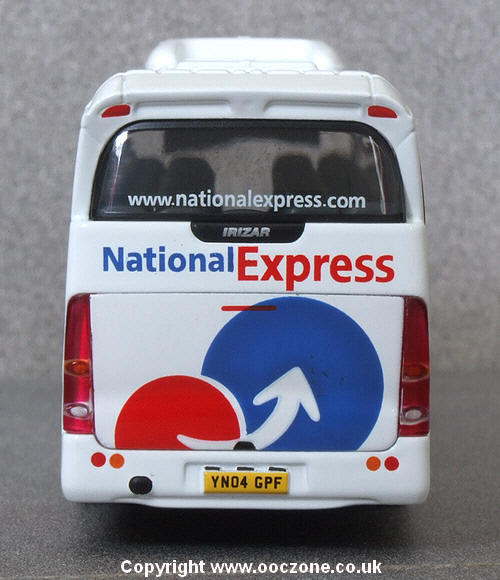 Etched
wiper blades are fitted to the clear front windscreen: apart from this
and the forward-most side windows all the other glazing on the model is
tinted black. The distinctive rabbit ear mirrors are nicely reproduced
and are combined with a smaller driving mirror assembly below the
drivers cab side window. These all have silver detailing applied on the
reverse to represent the several individual mirrors they house.
Etched
wiper blades are fitted to the clear front windscreen: apart from this
and the forward-most side windows all the other glazing on the model is
tinted black. The distinctive rabbit ear mirrors are nicely reproduced
and are combined with a smaller driving mirror assembly below the
drivers cab side window. These all have silver detailing applied on the
reverse to represent the several individual mirrors they house.
The front headlamp units are single piece components that convincingly capture the correct look and shape. Orange paint has been used behind these clear inserts to produce the direction indicator lenses and a similar process has been repeated to produce the large rear light clusters. All the other lights on the model have been added using tampo printing: however their appearance has been much improved by the fact they are applied to raised or recessed points on the casting giving them a more authentic three dimensional appearance.
 The
large front mounted air-conditioning unit takes up nearly half of the
roof space on the model and has a good level of detailing that includes
grilles and fan housings. Two escape hatches are reproduced on the
ribbed rear section of the roof.
The
large front mounted air-conditioning unit takes up nearly half of the
roof space on the model and has a good level of detailing that includes
grilles and fan housings. Two escape hatches are reproduced on the
ribbed rear section of the roof.
The rear engine cover is, in fact, a plastic component, but like the glazing this has been painted to match the rest of the body colour and doesn't stand out as such. The evenly applied paint finish is extremely good and thin enough not to mask any of the finer details of the casting. The tampo printed decals are also perfectly applied and have a very crisp appearance. The minute legal lettering and unladen weight details present on the lower near side panels are all fully legible although to actually read them you'll require a strong magnifying glass!
The internal detailing is probably the most disappointing aspect and appears to be a single piece grey plastic component containing all the seats and drivers dashboard, apart from the black steering wheel everything else remains undecorated, luckily the tinted glazing does a good job of disguising this somewhat bland feature. The model doesn't have any internal fixing poles or visible external fixing points.
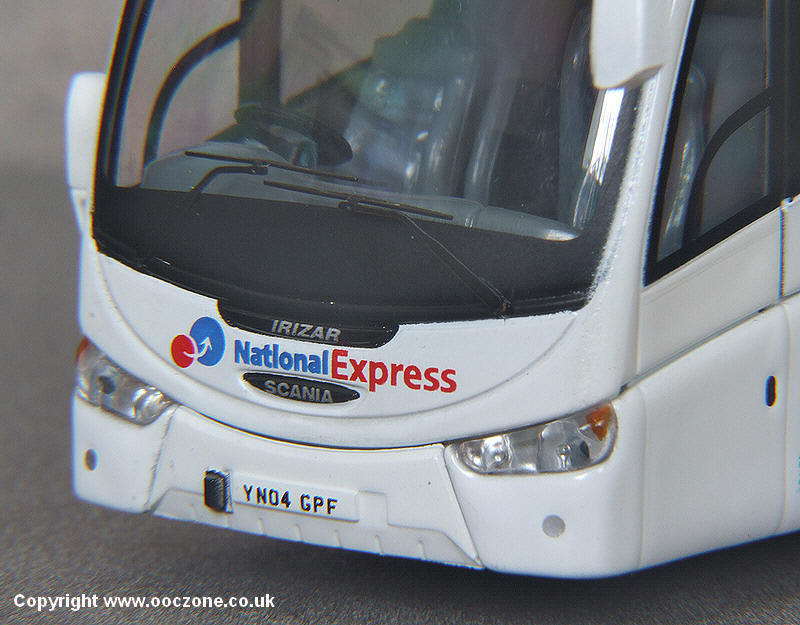
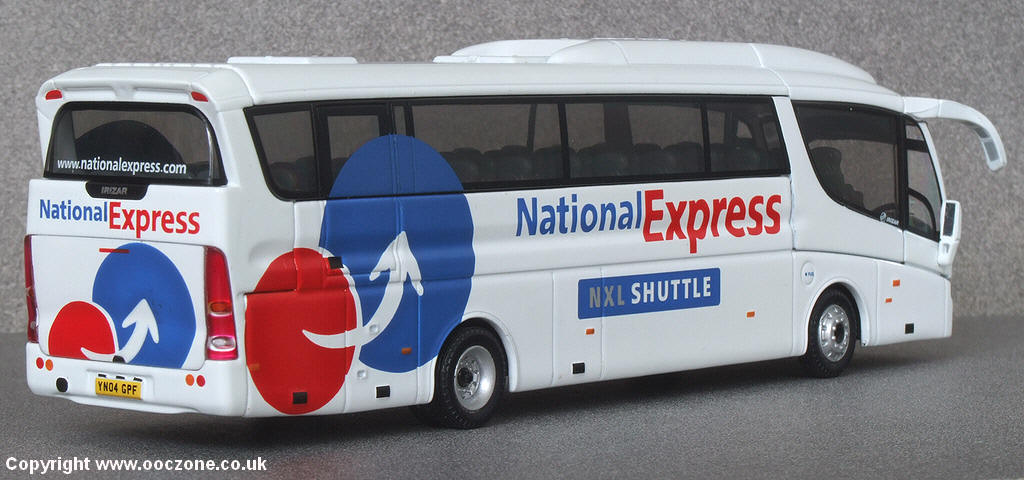 Overall
the shape of the coach has been well captured and can't be seriously
faulted. There are however a few very minor short comings. The must
noticeable of these is the rather heavy reproduction of the recessed
groove on the waistband below the side windows. This is very distinctive
on the model but doesn't appear to be such a strong feature on the real
vehicle. The other minor problems are encountered on the front - firstly
there should be a pair of thin air intake slits above the bumper,
although these are present on the casting (I believe they would be
better represented if picked out with some black paint as they are
actually very prominent on the real vehicles), and, secondly, I feel the
front side lights would have looked much better if they been recessed
more deeply into the lower corner panels.
Overall
the shape of the coach has been well captured and can't be seriously
faulted. There are however a few very minor short comings. The must
noticeable of these is the rather heavy reproduction of the recessed
groove on the waistband below the side windows. This is very distinctive
on the model but doesn't appear to be such a strong feature on the real
vehicle. The other minor problems are encountered on the front - firstly
there should be a pair of thin air intake slits above the bumper,
although these are present on the casting (I believe they would be
better represented if picked out with some black paint as they are
actually very prominent on the real vehicles), and, secondly, I feel the
front side lights would have looked much better if they been recessed
more deeply into the lower corner panels.
This new casting is certainly up there with the best of the OOC offerings. The first two releases were much anticipated and appear to have sold well. Corgi under its new Hornby ownership will certainly have plenty of livery options available for future releases. Two further releases have already been announced and Galway Citylink and Johnson Bros Tours models are expected to be released towards the end of this year. It will be interesting to see what's planned for this model in the forthcoming 2009 catalogue.
Kevin Ellis
For Kevin's review of OM46202, the Scania Irizar PB in 'Irish' livery. click
HERE
The opinions offered in the reviews on this page remain those of the author, and do not necessarily represent the of views of the Model Bus Website.

